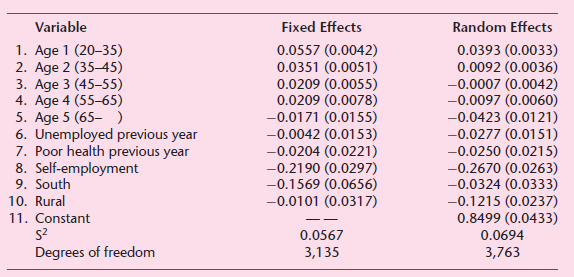Question:
Based on the Michigan Income Dynamics Study, Hausman attempted to estimate a wage, or earnings, model using a sample of 629 high school graduates, who were followed for a period of six years, thus giving in all 3,774 observations. The dependent variable in this study was logarithm of wage, and the explanatory variables were: age (divided into several age groups); unemployment in the previous year; poor health in the previous year; self-employment; region of residence (for graduate from the South, South = 1 and 0 otherwise) and area of residence (for a graduate from rural area, Rural = 1 and 0 otherwise). Hausman used both FEM and ECM. The results are given in the following table (standard errors in parentheses).

a. Do the results make economic sense?
b. Is there a vast difference in the results produced by the two models? If so, what might account for these differences?
c. On the basis of the data given in the table,which model, if any,would you choose?
Transcribed Image Text:
Random Effects Variable Fixed Effects 1. Age 1 (20-35) 2. Age 2 (35-45) 3. Age 3 (45-55) 4. Age 4 (55-65) 5. Age 5 (65- ) 6. Unemployed previous year 7. Poor health previous year 8. Self-employment 9. South 10. Rural 0.0557 (0.0042) 0.0351 (0.0051) 0.0209 (0.0055) 0.0209 (0.0078) -0.0171 (0.0155) -0.0042 (0.0153) -0.0204 (0.0221) -0.2190 (0.0297) -0.1569 (0.0656) -0.0101 (0.0317) 0.0393 (0.0033) 0.0092 (0.0036) -0.0007 (0.0042) -0.0097 (0.0060) -0.0423 (0.0121) -0.0277 (0.0151) -0.0250 (0.0215) -0.2670 (0.0263) -0.0324 (0.0333) -0.1215 (0.0237) 0.8499 (0.0433) 0.0694 3,763 11. Constant 0.0567 Degrees of freedom 3,135








